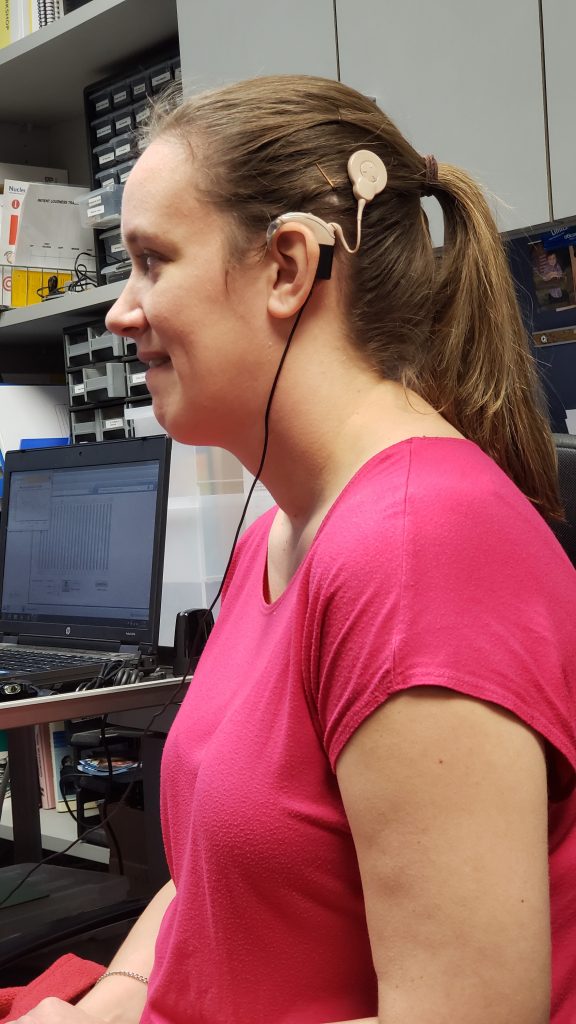We take many things for granted. That goes without saying, too often. But a recent experience with a truck on a TV really brought that home and I did not have time to really dwell on it until recently.
Angela received her second Cochlear brand Cochler Implant in early December 2020. Just before Christmas, her new implant was turned on. But we really could not do anything with it just yet. She had to get used to it first.
In January 2021, they upped the volume and she saw her normal audiologist. This is the one that I must remind insurance companies to cover as she is literally the only person in the Southeast qualified to handle Angela’s condition. After that appointment, Angela returned home, and we set about setting up her Bluetooth TV streamer.
The Journey
Back in 1997, Angela received a Cochlear Implant in her right ear from Bionic Ear, now Advanced Bionics. At the time, it was essentially experimental technology just years after Angela’s mom was told there was nothing that could be done for her. So, the fact this device could be installed at all was seen as a minor miracle at the time.
What it allowed was the then 12-year-old to really start picking up the language more easily to the point that she has a Southern inflection if you really listen to her. I have often joked with her that the reason Alexa doesn’t listen to her is that Amazon didn’t exactly expect to have to deal with Southern Deaf. But in terms of her communication, she only received the implant in one ear and relies heavily on reading lips.
She only received the implant in one ear because the thinking at that time was to “save” the other ear for a better technology that was to come along.
Fast forward to 2017 and we are working to get Angela back to her regular audiology appointments that she needs to keep her hearing processor in proper programming. These appointments are required because the nature of Angela’s condition means the implants are never truly fixed. They require constant adjustment.
We were having to deal with the aforementioned insurance companies after the Affordable Care Act proved it wasn’t and wading through the mountain of paperwork it now took to get anything covered. In order to get Angela’s audiologist covered by insurance, she first needed a referral from a doctor who could state he was inept to provide the same service. This started a journey where we would go doctor to doctor. Not because they refused to help us, but because they couldn’t.
Angela’s condition is so rare and unique, no one in Montgomery would even bother. It was out of their league. So, we went back to a doctor in Birmingham we had seen before. Unfortunately, even he was unable to help as Angela’s condition was even beyond his skill. So, he referred her to an ear specialist who was at UAB at the time.
This doctor ended up flipping the script on us. Rather than us looking for a referral to her audiologist so Angela could get her then 20-year-old implant tuned, he asked if she thought about upgrading it.
This took us aback. She had never considered it. Up to this point, no one would even touch her! Not only that, but he also said she was eligible for implantation on the other side! Angela had only had hearing on her right side for twenty years and now the doctor was not only talking about upgrading it but allowing her to add the left side as well!
The medical thinking had changed in 20 years. It no longer made sense to “save” a good ear. “Use or lose” works for all aspects of your brain. So, we had a decision to make. We simply wanted a tune-up. Now we were talking a full replacement.
What is it?
There are better guides than this, but what a Cochlear Implant entails is putting a wire with a series of electrodes on one end within the cochlea of the ear. The other end has a magnet and an induction receiver that is then implanted under the scalp.
Angela then wears an external processor that is held in place by the magnet and gravity. Sound is picked up by a microphone and converted into an electrical signal. That signal is then sent down that wire into her cochlea where the electrodes generate electrical impulses. Those impulses are then translated as sound by the brain.
The number of electrodes determine the frequency range of the implants and the volume is handled by increasing the voltage. Sound bypasses the ear canal completely. To upgrade from her 1997 model to her 2017 model was the equivalent of upgrading from an AM radio to a digital Dolby surround system. That is the change in technology we are talking about. The number of electrodes grew exponentially.
The new ones
As we came to the decision, we decided to get the new implant before we replaced the old one. Our thinking was simple: let her get used to the new one while she still has the old one to fall back on rather than completely take away all her hearing for a period of time. The doctor and her parents agreed that was a good plan.
The first surgery ended up being more eventful than it should have been. While wrapping up an otherwise routine implantation, the assistant to the surgeon noticed Angela had a rash on her leg and immediately realized what was going on. Angela was having an anaphylactic reaction to the bacitracin they used to sterilize the implant and implant site. They ended up having to intubate and resuscitate her but saved her life.
After a few nights in the ICU, Angela was able to go home. A month later, she shed several tears as she heard out of the left side of her head for the first time since what little hearing she ever had there disappeared as a child.

Turning on the left side for the first time.
After a series of tests to positively narrow down what Angela was (and was not) allergic to, and after another round of dealing with “improved access to healthcare” thanks to the Affordable Care Act, we finally got Angela’s second implant installed, replacing the original 1997 model two years after the first surgery. This surgery was far less eventful, and the surgeon even waited until Angela was awake before coming to see me. The hospital staff were made well aware of the last surgery and all made it their personal mission to make sure Angela walked into my car that evening.
A new world
Now in January 2021, Angela now has both processors turned on and I spend an hour dealing with the weird user interface provided by the Cochlear company to get Angela’s TV streamer working. To test it, I went into the Disney+ app and picked a random movie on the front screen, which oddly enough ended up being a Fox movie.
The movie starts with a truck entering the frame from the left and driving to the right as the camera pans to follow. After about ten seconds, I press pause and ask Angela if it sounds okay because I obviously cannot hear what she is hearing. She looked at me concerned and said, “the truck sound started on the left and then moved to the right and then the sound matched on the next scene.”

I grinned a little as I realized why she said that. At 35 years old, she had never heard stereo sound in a movie before! Since she received her second implant in 2018, she could hear the speakers in both ears and there is some help in terms of localizing sounds, but the external mics on her processors do not have the kind of nuance that our ears have. It was not until I set up a direct Bluetooth connection directly to both of her implants that she and I realized what she had been missing all these years.
Taking for granted
I always took that level of detail for granted. I knew I could hear better than her; that was always a given. In fact, Angela sometimes talks at a volume that makes me think she forgets my hearing is fine. But when I ran the audio for the video stream at FBC Huntsville, I would mix it so that the various instruments would sound like the were in the middle of the sound stage if you were watching with headphones. Even if you weren’t in the room, I wanted you to feel like you were. Up until January of this year, Angela would have never been able to enjoy that experience.
We still have our struggles. The new technologies simply fill a gap. We still watch TV with captions, and I still have to repeat myself if I’m talking to her and she can’t see my face, even when she has both processors on. And I still handle most official phone conversations for her.
But for me, of this entire adventure, the one thing that I will remember most will be that truck driving across the screen and being there as she experienced that for the first time. Unlike when she received her second implant, there were no tears. But the look of wonder was something I will never forget.

